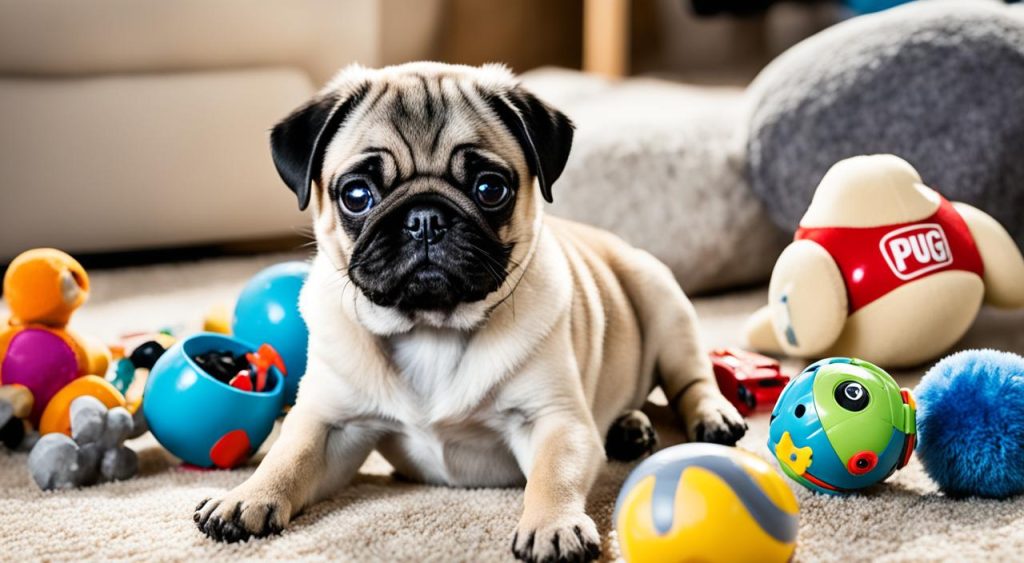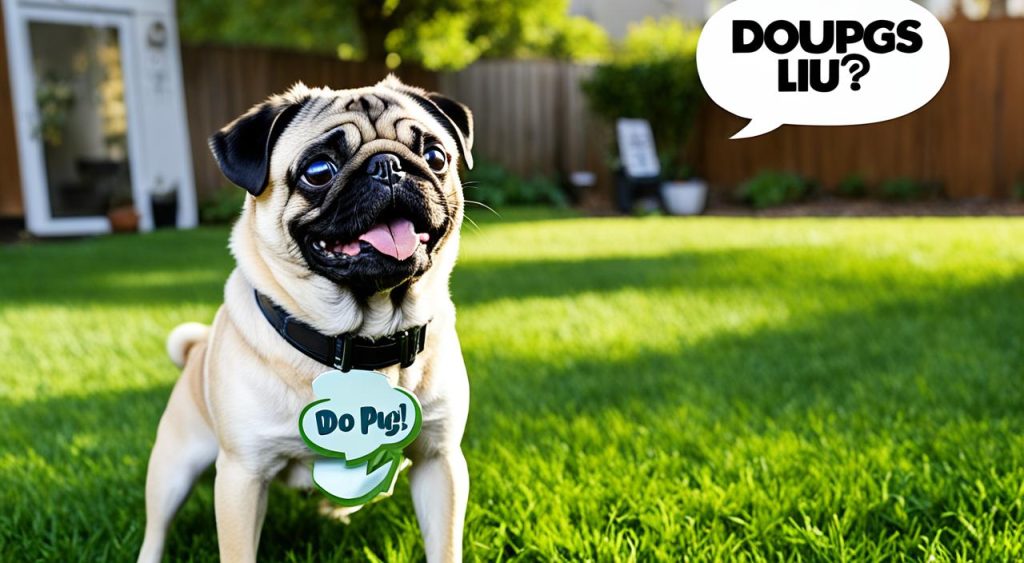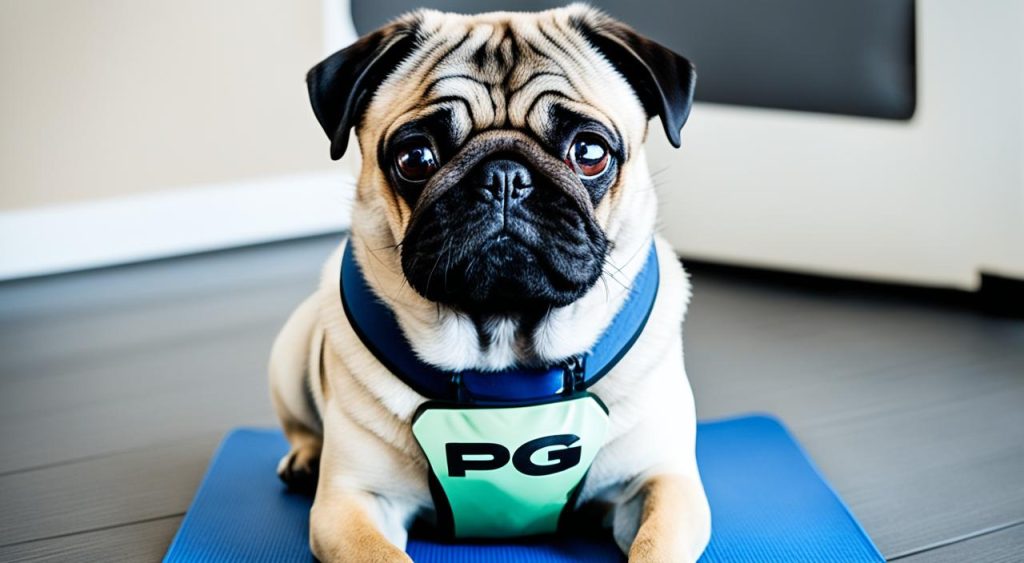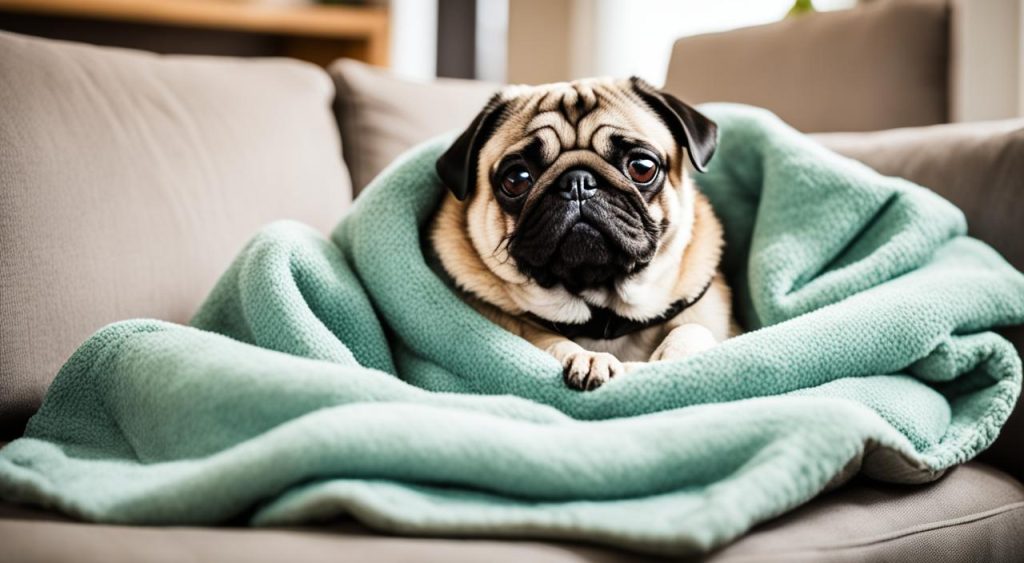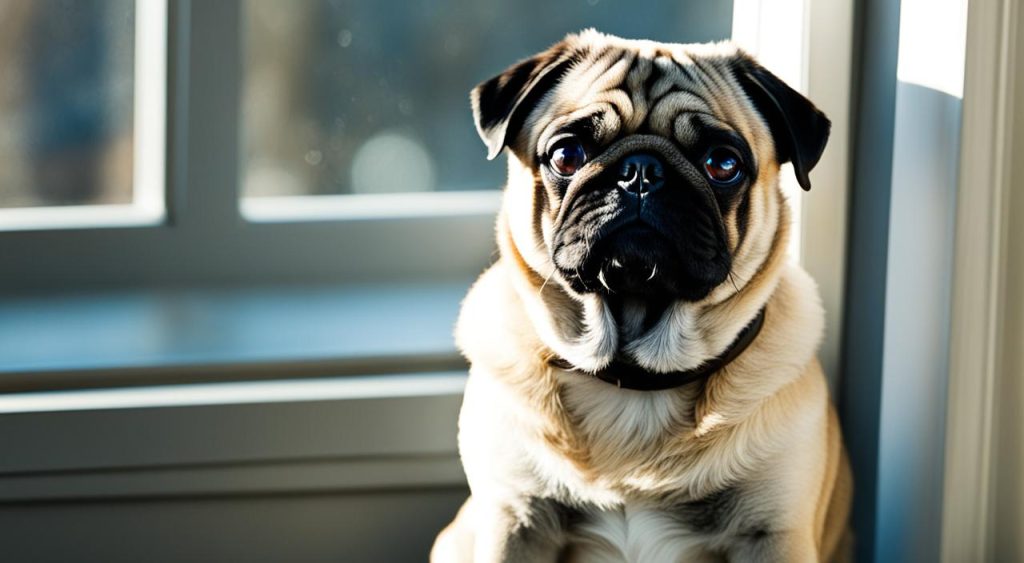Pugs are beloved for their lovable and even-tempered behavior. But have you ever wondered if these adorable dogs can actually get their feelings hurt? In this article, we’ll explore the emotions of pugs and how they may be affected by various factors in their environment.
Key Takeaways:
- Pugs are generally sensitive to their environment and the tone of voice used by their owners.
- They thrive in a positive and low-key atmosphere, and may become emotionally withdrawn if subjected to harsh discipline.
- Pugs exhibit certain personality traits, such as stubbornness and a craving for attention.
- Training methods that involve positive reinforcement, such as praise and rewards, work well with pugs.
- Establishing rules and boundaries, as well as providing a comfortable indoor environment, are important for pug training.
Behavior and Temperament of Pugs
Pugs are known for their comical and friendly nature. They are generally friendly and get along well with other dogs and children. However, they may be skittish around larger dogs and can be vulnerable to more aggressive canines.
Pugs have a tendency to mimic their owners’ behaviors and adapt to their owner’s personality. They are highly perceptive and can often mirror the emotions and actions of those around them. Their ability to adapt makes them great companions that can easily fit into different households.
Pugs have moderate energy levels and enjoy short walks for exercise. They appreciate daily physical activity but may not require intense exercise like some other breeds. Regular walks and playtime can help keep them healthy and mentally stimulated.
Pugs: Sensitive and Emotional
Pugs are sensitive to their surroundings and can easily pick up on the emotions of their owners. They have a remarkable ability to sense when their humans are feeling down or stressed, offering comfort and companionship. Their intuitive nature makes them great emotional support animals.
However, this sensitivity can also make Pugs prone to anxiety and depression if they are left alone for long periods of time. They thrive on human interaction and may experience separation anxiety when their owners are away. Providing them with plenty of attention, mental stimulation, and a safe environment can help alleviate these issues.
Pugs are known for their expressive faces and are masters at captivating their owners’ emotions with a single look. Their big, round eyes and wrinkled brows can melt hearts and make them irresistible companions.
Pug Training Tips
Training a pug can be a rewarding experience, but it requires consistency and patience. Positive reinforcement is the key to success when it comes to pug training. Pugs are motivated by food and love to please their owners.
Housebreaking a pug may require some extra attention. Pugs are known to suffer from separation anxiety if left alone for long periods of time. To help alleviate this issue, crate training can be beneficial. Provide a comfortable indoor environment for your pug and establish a routine to make them feel secure.
When training your pug, it’s important to establish yourself as the leader. Set clear rules and boundaries and be consistent with your expectations. Pugs thrive when they know what is expected of them.
Remember to use positive reinforcement techniques, such as praise and treats, to encourage good behavior. Pugs are eager to please their owners and will respond well to rewards.
“Consistent training and positive reinforcement are the keys to success when training a pug. With a little patience and love, your pug will learn and thrive.”
Pug Begging and Feeding Tips
Pugs are notorious for their knack for begging, especially if they’ve been spoiled with food from their owner’s plate in the past. To maintain a healthy feeding routine, it’s crucial to establish clear rules and guidelines for your pug’s meals and stick to a consistent schedule. By doing so, you can prevent their persistent begging and ensure they’re receiving proper nutrition.
When it comes to treats and snacks, it’s best to reserve them for training sessions and as rewards for good behavior. This will help reinforce positive habits and prevent overindulgence. Additionally, teaching your pug to sit patiently before meals can create a calm and controlled feeding environment.
“Establishing a structured feeding routine and teaching your pug good manners around food helps promote their overall well-being and prevent any potential behavior issues.”
It’s essential to remember that feeding your pug directly from your plate can encourage their begging behavior. While it may be tempting to share your food, it’s best to avoid this habit to maintain a healthy diet for your pug. Remember, their nutritional needs may differ from yours, and consulting a veterinarian can help assess their specific dietary requirements.
If your pug seems constantly hungry despite following a regular feeding schedule, it may be necessary to evaluate the quality and quantity of their meals. Consult with your vet to ensure your pug’s nutritional needs are being met. They can provide guidance on suitable food choices and portion sizes for your furry companion.
Pug Chewing and Teething
Chewing is a natural behavior for dogs and is often triggered by teething or boredom. Pugs, like other puppies, may chew on objects during the teething phase. It is important to puppy-proof the environment and provide appropriate chew toys to satisfy their urge to chew.
“During the teething phase, your Pug’s gums may be sore and sensitive. Providing ice cubes or chilled teething toys can help soothe their gums and alleviate discomfort,” says Dr. Emily Thompson, a veterinarian specializing in canine behavior.
Pugs have a strong natural instinct to chew, and it’s crucial to direct this behavior towards appropriate objects. “By offering a variety of chew toys designed specifically for teething puppies, you can redirect their chewing habits and prevent destructive behavior,” advises Dr. Thompson.
It’s important to keep personal items, such as shoes or household objects, out of your Pug’s reach to avoid destruction. Establishing boundaries and redirecting their attention towards chew toys will help to discourage chewing on inappropriate objects.
Teaching your Pug appropriate chewing behavior early on is essential in preventing destructive habits. By consistently reinforcing positive behaviors and providing them with appropriate outlets for chewing, you can help your Pug develop healthy chewing habits that can last a lifetime.
Pug Sensitivity and Temperament
Pugs are known for their sensitivity and adaptability to their environment and the emotions of their owners. They thrive in a low-key and positive atmosphere, where their gentle nature can truly shine. Pug sensitivity is particularly evident when it comes to the tone of voice used by their owners. They are highly receptive to the emotional cues conveyed through tone and can become emotionally distressed by harsh words or yelling. As a pug owner, it is essential to provide a nurturing and non-judgmental environment to prevent pug sensitivity issues.
Pugs are highly perceptive and tend to mirror the behaviors and temperament of their owners. They are quick to pick up on your moods, and your actions can deeply impact their own emotional state. It is important to be mindful of your actions and maintain a calm and positive demeanor around your pug. By modeling the behavior and temperament you desire in your pug, you can encourage them to thrive emotionally.
“Pugs are incredibly sensitive creatures who require a loving and supportive environment to flourish. Sudden outbursts or negative reinforcement can make them emotionally withdrawn, so it’s crucial to use positive, gentle training techniques to maintain their trust and well-being.” – Dr. Emily Johnson, Veterinarian
Rewarding good behavior is key to nurturing a pug’s emotional well-being. When your pug exhibits positive behaviors, such as following commands or displaying calmness, be sure to provide ample praise and reward. Positive reinforcement motivates pugs and helps build their confidence and trust in you. Avoid punishment or yelling, as these can deeply distress a pug and lead to withdrawal and anxiety.
Pug sensitivity also extends to their need for love, attention, and non-judgmental support. They thrive on human companionship and require regular interaction and affection to feel secure and emotionally fulfilled. Spending quality time with your pug through activities such as playtime, cuddling, and gentle walks can contribute to their emotional well-being.
Pug Temperament: Adaptable and Affectionate
Pugs are known for their adaptable and affectionate nature. They have a friendly disposition and tend to get along well with other dogs and children. However, they may feel intimidated or be skittish around larger dogs and can be vulnerable to more assertive canines. Pug temperament can vary from individual to individual, but their overall friendliness and sociability make them great companions.
To ensure a balanced temperament in your pug, it is important to provide them with regular socialization opportunities. This can include supervised interactions with other dogs, visits to dog parks, or obedience classes. Socialization helps pugs feel more comfortable and confident in various situations, reducing the likelihood of anxiety or aggressive behavior.
Understanding and respecting the sensitivity and temperament of your pug is essential for their overall emotional well-being. By providing a loving, positive, and nurturing environment, you can help your pug thrive emotionally and enjoy a happy, well-adjusted life.
Pug History and Characteristics
Pugs have a rich history that dates back to ancient times, making them one of the oldest dog breeds. These adorable canines were originally kept as companion dogs by Chinese emperors and were considered a symbol of good luck. Their long-standing presence in human history speaks to their enduring appeal.
One of the most distinguishing features of pugs is their unique set of characteristics. They have a square and muscular build, which gives them a sturdy appearance. Their round and flat faces are accentuated by deep wrinkles that add to their endearing charm. Pugs also have large dark eyes that can melt any heart.
Pugs come in a variety of colors, including fawn, black, silver, and apricot. However, their most iconic feature is their underbite, which gives them a comical expression that is hard to resist. This distinctive physical trait adds to their lovable and playful nature.
Aside from their physical attributes, pugs are known for their friendly and affectionate temperament. They have a natural affinity for human companionship and make wonderful family pets, particularly for families with small children. Their loving and social nature ensures that they quickly become an irreplaceable part of the family.
Conclusion
Pugs are unique and endearing dogs with lovable personalities. Despite their stubbornness and tendency to beg for food, they can be easily trained through consistent methods and positive reinforcement. These sensitive dogs thrive in a supportive and loving environment, where their emotions are well understood.
With their distinct characteristics and rich history, Pugs have become a beloved breed among many pet owners. Their square and muscular build, flat faces, wrinkles, and expressive eyes make them instantly recognizable. Pugs’ friendly and affectionate nature makes them a perfect addition to families with small children.
To ensure the happiness and well-being of your Pug, it’s important to be attuned to their behaviors and emotions. Creating a positive atmosphere with lots of love and attention will help them flourish. By understanding their unique needs and providing proper training and nurturing, you can enjoy a fulfilling and rewarding companionship with your Pug.

